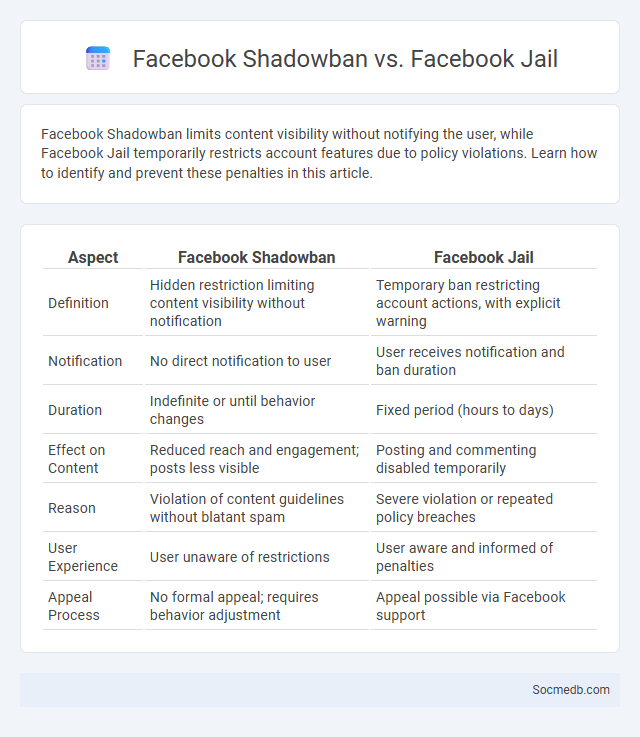
Photo illustration: Facebook Shadowban vs Facebook Jail
Facebook Shadowban limits content visibility without notifying the user, while Facebook Jail temporarily restricts account features due to policy violations. Learn how to identify and prevent these penalties in this article.
Table of Comparison
| Aspect | Facebook Shadowban | Facebook Jail |
|---|---|---|
| Definition | Hidden restriction limiting content visibility without notification | Temporary ban restricting account actions, with explicit warning |
| Notification | No direct notification to user | User receives notification and ban duration |
| Duration | Indefinite or until behavior changes | Fixed period (hours to days) |
| Effect on Content | Reduced reach and engagement; posts less visible | Posting and commenting disabled temporarily |
| Reason | Violation of content guidelines without blatant spam | Severe violation or repeated policy breaches |
| User Experience | User unaware of restrictions | User aware and informed of penalties |
| Appeal Process | No formal appeal; requires behavior adjustment | Appeal possible via Facebook support |
Understanding Facebook Shadowban: Definition and Implications
Facebook shadowban refers to the platform's covert restriction of a user's content, limiting its visibility without notification. This practice significantly reduces engagement by preventing posts from appearing in followers' feeds and search results, impacting content reach and audience growth. Understanding the implications of a Facebook shadowban is crucial for optimizing social media strategies and maintaining effective digital communication.
What is Facebook Jail? Key Differences Explained
Facebook Jail refers to a temporary ban imposed on users who violate the platform's community standards or terms of service, restricting their ability to post, comment, or interact. Unlike permanent bans, Facebook Jail lasts for a limited period, typically ranging from 24 hours to 30 days, depending on the severity of the violation. Your understanding of these key differences helps you avoid repeated offenses and maintain active engagement on the platform.
Shadowban in General: A Broader Look Across Platforms
Shadowban affects your visibility across various social media platforms by quietly limiting your content's reach without notification, impacting engagement and growth. This practice targets users suspected of violating community guidelines or exhibiting spam-like behavior, making it crucial to understand platform-specific rules and avoid actions that trigger restrictions. Recognizing signs of shadowbanning on platforms like Instagram, Twitter, or TikTok enables you to adjust your content strategy and maintain authentic interaction with your audience.
How Facebook Shadowbans Work: Signs and Symptoms
Facebook shadowbans restrict content visibility without notifying users, causing posts to appear in fewer feeds and search results. Common signs include sudden drops in engagement, absence from hashtag searches, and no new followers despite consistent activity. This algorithmic suppression targets behavior perceived as spammy or violating community standards, reducing reach stealthily.
The Mechanics of Facebook Jail: Causes and Consequences
Facebook Jail occurs when users violate platform policies, triggering automated or manual content moderation systems designed to maintain community standards. Common causes include posting offensive language, hate speech, misinformation, or spamming activities, which result in temporary account restrictions ranging from hours to weeks. These penalties limit user interaction abilities such as posting, commenting, or messaging, often leading to reduced engagement and potential damage to personal or business reputations on the platform.
Shadowban vs. Facebook Jail: A Direct Comparison
Shadowban restricts user content visibility without notification, reducing reach on platforms like Instagram or Twitter. Facebook Jail temporarily blocks users from posting or commenting due to policy violations, clearly informing them of the suspension duration. Both limit user interaction, but shadowbanning is covert, while Facebook Jail is explicit and time-bound.
Typical Triggers for Getting Shadowbanned on Facebook
Repeatedly posting identical content or engaging in spam-like behavior typically triggers shadowbanning on Facebook. Using banned hashtags, sharing misinformation, or violating community standards increases the risk of content suppression. Excessive automation, fake accounts, and frequent reports from other users also contribute to reduced visibility on the platform.
Common Reasons for Ending Up in Facebook Jail
Repeatedly posting content that violates Facebook's community standards, such as hate speech, misinformation, or graphic violence, often leads to temporary bans known as Facebook Jail. Excessive sending of friend requests or messages perceived as spam triggers automatic restrictions to prevent harassment. Engaging in coordinated inauthentic behavior or using fake profiles also results in account suspensions to maintain platform integrity.
How to Detect and Recover from a Shadowban or Facebook Jail
Shadowbans and Facebook Jail restrictions limit your social media reach by reducing content visibility or temporarily blocking account features. You can detect these issues by monitoring sudden drops in engagement, receiving notifications about policy violations, or testing content visibility through different accounts. To recover, review and comply with platform guidelines, appeal restrictions via Facebook's support channels, and avoid repetitive actions that trigger automated enforcement mechanisms.
Best Practices to Avoid Facebook Shadowban and Jail
Maintaining authentic engagement and avoiding spammy behaviors are key best practices to prevent Facebook shadowban and jail. Consistently adhering to Facebook's community standards, avoiding excessive posting or repetitive comments, and using original content can significantly reduce the risk of penalties. Monitoring account activity through Facebook Insights helps identify potential issues early and ensures compliance with platform guidelines.
 socmedb.com
socmedb.com